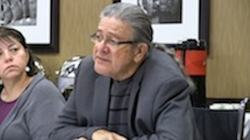The Lakota People's Law Project
worked in association with A Positive Tomorrow and the Sioux Tribes of
South Dakota to bring Indian tribes closer to running their own
independently run foster care systems.
Rapid City, South Dakota (PRWEB) October 06, 2014
Two tribes of the Lakota Sioux Nation in South Dakota Indian Country
have been awarded planning grants by the Department of Health and Human
Services, marking a historic moment in the ongoing effort to stop the
illegal State seizure of Lakota children by creating an independent tribal-run family services program administered for Lakota, by Lakota.
Both the Oglala Sioux Tribe at Pine Ridge and Standing Rock Sioux
Tribe were awarded $300,000 planning grants by the United States Health
and Human Services Agency, according to an HHS announcement released
Friday, Oct. 3.
“This is a tremendous development,” said Oglala Sioux President Bryan
Brewer. “ Credit goes first to all the tribes for our hard work, and
second to
A Positive Tomorrow, whose expertise in grant applications of
this specific kind has been indispensable to this achievement, and
finally to the
Lakota People’s Law Project who has worked for years with us for this structural change.”
“Our children are sacred, and they are our future,” said Chase Iron
Eyes, spokesperson from the Standing Rock Sioux Tribe and attorney for
the Lakota People’s Law Project. “This is a significant victory for the
Lakota people and for indigenous people across the United States and
around the globe, and it marks the beginning of a major effort to build
our tribal capacity so we can take care of our children and families.”
Jesse Taken Alive, former Chairman of Standing Rock said, “ We will
be working on our constitutions, our customary laws and traditions, our
Court system, our codes, our available buildings, our kinship and foster
care networks, our educational access to Masters Degrees, our creation
of these permanent jobs, and our trauma and parent training based on our
own values. This effort will strengthen our families and build tribal
capacity across our structures.”
Yvonne Ito of A Positive Tomorrow, who worked diligently with seven
tribes to ensure the applications were high grade, joined Iron Eyes in
expressing a sense of triumph while cautioning that much work remains.
“We are pleased that these two tribes will embark on a journey of
sovereignty, and we will continue to fight for the other five Sioux
tribes to receive their planning grants as well.”
The Department of Health and Human Services gives five tribal planning grants per year, and
this year they gave two in South Dakota, two in Alaska, and one in Arizona.
“I am committed to the tribes and to a working alliance with the
Lakota People’s Law Project,” said Ito. “If we all continue to work
together, all Lakota tribes will rise in this historic project with the
People of the Seven Council Fires. There is a lot of work to be done
and this latest benchmark only strengthens our resolve and determination
to make sure it gets done successfully.”
The federal grants of $300,000 are distributed to each tribe by
mid-October and will allow Standing Rock Sioux Tribe, and the Oglala
Sioux Tribe at Pine Ridge, to begin planning and building capacity with a
final goal of establishing foster care systems that will be run by the
tribes independent of the state. Collective efforts will continue this
month to achieve planning grants for the Yankton, Crow Creek, Cheyenne
River, Flandreau, and Lower Brule Sioux tribes.
“It is crucial that we wrest control of our children’s future away
from members of the state of South Dakota, who have proven over and over
again that they do not have the best interests of our children and
families at heart,” said Cheyenne River Grandmother Madonna Thunder
Hawk. “Our children are not cash cows for federal money coming into the
state economy, they are sacred and precious beings, our most valuable
resource.”
“The people best situated to care for our children are our own
families and extended family network, which we call Tiospaye,” said
Phyllis Young, Standing Rock Councilwoman and important initiator of the
historic BIA Summit on Lakota Foster Care in 2013. “We have taken good
care of our children for thousands of years. We have to heal from the
trauma of the past 130 years and begin to build a positive future for
our people.”
The Lakota People’s Law Project (LPLP) has been working on foster
care issues relative to the Native American children of South Dakota
since 2005, partnering with tribes and leaders in South Dakota.
The tribes have been prompted to run their own foster care institutions after
a 2011 report by National Public Radio
asserted that the South Dakota Department of Social Services repeatedly
and persistently violates the Indian Child Welfare Act of 1978, and
receives roughly $65 million per year in federal money in the process.
The federal money infusions for the South Dakota foster care program
were detailed in
Who’s Watching the Watchdog, a 2013 report by the Lakota People’s Law Project.
An average of 742 Native American children are removed from their
homes in South Dakota on an annual basis, according to the United States
Children' Bureau's "
Child Welfare Outcomes: Reports to Congress."
When controlling for the factor of poverty, South Dakota still ranks
third in the nation for the highest number of children taken into
custody by the Department of Social Services, according to the National
Coalition for Child Protection Reform's
"2010 NCCPR Rate of Removal Index." This is true even though the state has a total population of only 844,000.
While Native American children constitute 13.5 percent of the child
population in South Dakota, they comprise 54 percent of the youth foster
care population, according to the Child Welfare Outcomes compiled by
the Children's Bureau. South Dakota has allegedly continued to ignore
stipulations in ICWA that mandate placement of Native American children
in Native American homes, placing about 87 percent of Native children in
non-Native homes, according to data provided by the South Dakota DSS to
LPLP in an email in 2011.
“The state of South Dakota operates under a perverse incentive, where
they actually stand to gain additional federal funding for their social
services programs by taking Native kids from their homes and placing
them in state-run foster care services,” said Sara Nelson of the Lakota
People’s Law Project. “Most of the group homes are now psychiatric
institutions, because they can charge the federal government three times
as much per day.”
This crisis prompted LPLP, after much grassroots research and legal
analysis, to begin advocating a solution that entailed the tribes
running their own independent and autonomous family services programs
that include foster care homes.
“We were happy to see that Governor Daugaard has now endorsed the
shifting of the federal money from the State to the tribes for foster
care,” said Yankton Sioux Tribe Officer Sam Sully, referring to an
announcement in the Argus Leader last year. “We are pushing forward to
ask three Washington, D.C. agencies for our planning grant too.”
The two announced grants will arrive in mid October when the tribes
will proceed immediately to hire qualified Planning Coordinators.
The planning grant applications were submitted for funding under the
terms of the 2008 Fostering Connections to Success and Increasing
Adoptions Act, commonly referred to as the Baucus Act. The law
introduced major changes to the Social Security Act, primarily in
Section IV-E, regarding foster care and adoptions assistance payments to
the states.
The Planning Grant program under the
Baucus Act
can award individual planning grants up to $300,000 to American Indian
tribes and has a total annual budget of $3 million. Usually $1.5
million in grants, or 5 grants, are given each year. According to the
Tribal Directory of the Bureau of Indian Affairs there are 566 federally
recognized tribes. At this rate, the process could take upwards of 100
years.
In total, eight out of the nine Lakota tribes in South Dakota have
already received or applied for the grants. Five are asking for further
review in Washington, D.C.
The Lakota People’s Law Project
has been partnering with tribes and leaders in South Dakota since 2005
from its offices in Rapid City, SD and Santa Cruz, CA. LPLP’s activities
have included funding and supporting Native experts to provide
technical assistance to the tribes on family and child welfare issues.
The project combines public interest law, investigation, research,
education, and organizing into a unique model for advocacy and social
reform.
The Lakota People's Law Project is sponsored by the non-profit Romero
Institute based in Santa Cruz, California. The Institute is named after
slain human rights advocate Archbishop Oscar Romero of El Salvador. The
Institute seeks to identify and dismantle structural sources of
injustice and threats to the survival of our human family.































NOMINATED: Trio Solutions (Baby Veronica case)
The same professional PR firm that targeted Baby Veronica's father Dusten Brown, pulled out their arrows again and aimed them at yet another father in yet another contested adoption. The exact same tactics (purchasing Facebook likes; setting up an online shop to raise money in a child's name; smearing the father through any means necessary, including nationally-launched press releases; calling in the national press, including CNN; purposely working the public up into an angry lather; having their contractors set up websites to incite anger and hatred of the bio father) were used on John McCaul this year and last. They attempted the same thing with other children's biological families as well, including Baby Dee.
So, I would like to nominate them for their role in meddling in adoption cases and using the weight and cost of an entire Public Relations team to target poorer, less social media savvy birth families.